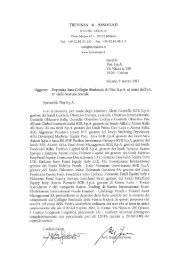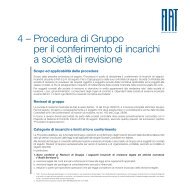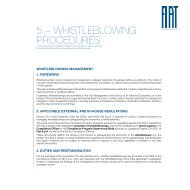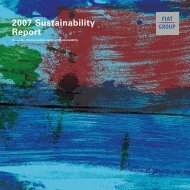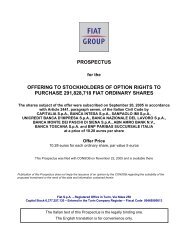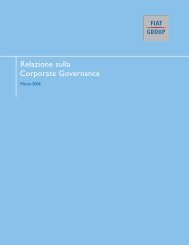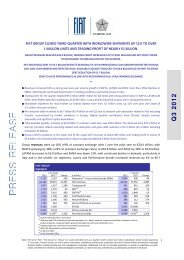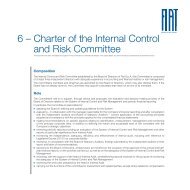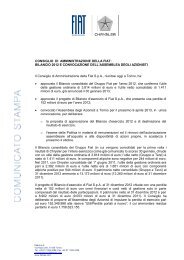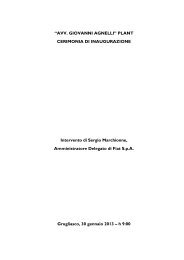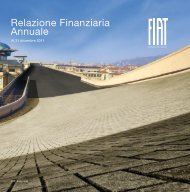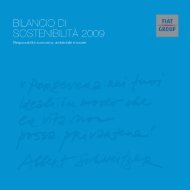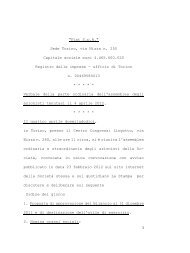annual report - FIAT SpA
annual report - FIAT SpA
annual report - FIAT SpA
You also want an ePaper? Increase the reach of your titles
YUMPU automatically turns print PDFs into web optimized ePapers that Google loves.
� Cash flow hedges – Where a derivative financial instrument is designated as a hedge of the exposure to<br />
variability in future cash flows of a recognised asset or liability or a highly probable forecasted transaction and<br />
could affect the income statement, the effective portion of any gain or loss on the derivative financial instrument<br />
is recognised directly in other comprehensive income. The cumulative gain or loss is removed from other<br />
comprehensive income and recognised in the income statement at the same time as the economic effect<br />
arising from the hedged item affects income. The gain or loss associated with a hedge or part of a hedge that<br />
has become ineffective is recognised in the income statement immediately. When a hedging instrument or<br />
hedge relationship is terminated but the hedged transaction is still expected to occur, the cumulative gain or<br />
loss realised to the point of termination remains in other comprehensive income and is recognised in the<br />
income statement at the same time as the underlying transaction occurs. If the hedged transaction is no longer<br />
probable, the cumulative unrealised gain or loss held in other comprehensive income is recognised in the<br />
income statement immediately.<br />
� Hedges of a net investment – If a derivative financial instrument is designated as a hedging instrument for a net<br />
investment in a foreign operation, the effective portion of the gain or loss on the derivative financial instrument<br />
is recognised in other comprehensive income. The cumulative gain or loss is reclassified from other<br />
comprehensive income to profit or loss on the disposal of the foreign operation.<br />
If hedge accounting cannot be applied, the gains or losses from the fair value measurement of derivative financial<br />
instruments are recognised immediately in the income statement.<br />
Sales of receivables<br />
The Group sells a significant part of its financial, trade and tax receivables through either securitisation programs or<br />
factoring transactions.<br />
A securitisation transaction entails the sale of a portfolio of receivables to a securitisation vehicle. This special<br />
purpose entity finances the purchase of the receivables by issuing asset-backed securities (i.e. securities whose<br />
repayment and interest flow depend upon the cash flow generated by the portfolio). Asset-backed securities are<br />
divided into classes according to their degree of seniority and rating: the most senior classes are placed with investors<br />
on the market; the junior class, whose repayment is subordinated to the senior classes, is normally subscribed for by<br />
the seller. The residual interest in the receivables retained by the seller is therefore limited to the junior securities it<br />
has subscribed for. In accordance with SIC 12 – Consolidation – Special Purpose Entities (SPE), all securitisation<br />
vehicles are included in the scope of consolidation, because the subscription of the junior asset-backed securities by<br />
the seller entails its control in substance over the SPE.<br />
Furthermore, factoring transactions may be with or without recourse to the seller; certain factoring agreements without<br />
recourse include deferred purchase price clauses (i.e. the payment of a minority portion of the purchase price is<br />
conditional upon the full collection of the receivables), require a first loss guarantee of the seller up to a limited amount<br />
or imply a continuing significant exposure to the receivables cash flow. These kinds of transactions do not meet<br />
IAS 39 requirements for asset derecognition, since the risks and rewards have not been substantially transferred.<br />
Consequently, all receivables sold through both securitisation and factoring transactions which do not meet IAS 39<br />
derecognition requirements are recognised as such in the Group financial statements even though they have been<br />
legally sold; a corresponding financial liability is recorded in the consolidated statement of financial position as Assetbacked<br />
financing. Gains and losses relating to the sale of such assets are not recognised until the assets are removed<br />
from the Group statement of financial position.<br />
Inventories<br />
Inventories of raw materials, semi finished products and finished goods, (including assets leased out under operating<br />
leases and assets sold under a buy-back commitment that are held for sale) are stated at the lower of cost and net<br />
realisable value, cost being determined on a first in-first-out (FIFO) basis. The measurement of inventories includes<br />
the direct costs of materials, labour and indirect costs (variable and fixed). Provision is made for obsolete and slowmoving<br />
raw materials, finished goods, spare parts and other supplies based on their expected future use and<br />
realisable value. Net realisable value is the estimated selling price in the ordinary course of business less the<br />
estimated costs of completion and the estimated costs for sale and distribution.<br />
The measurement of construction contracts is based on the stage of completion determined as the proportion that<br />
cost incurred to the balance sheet date bears to the estimated total contract cost. These items are presented net of<br />
progress billings received from customers. Any losses on such contracts are fully recorded in the income statement<br />
when they become known.<br />
Fiat Group Consolidated Financial Statements at 31 December 2010 118



